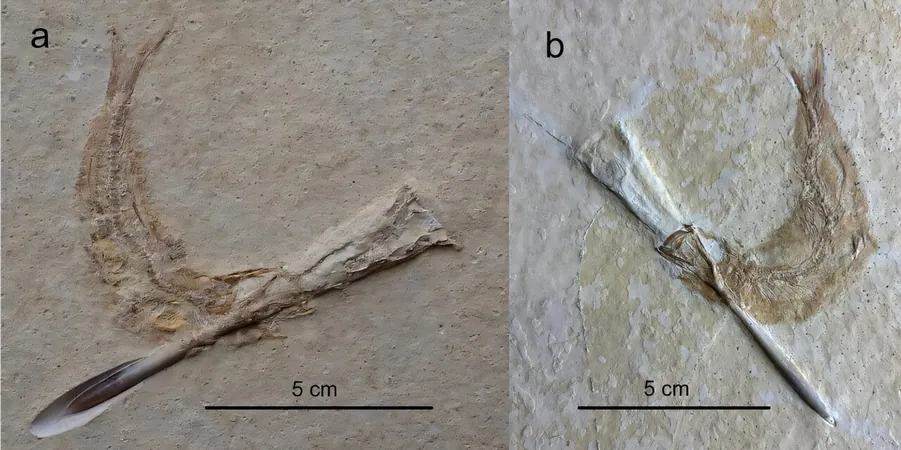
Shocking Discoveries: Blue Rings in Trees Reveal Past Cold Summers Linked to Volcanic Eruptions!
2025-01-22
Author: Li
Introduction
Recent scientific investigations have unveiled an intriguing phenomenon: the blue rings found in tree trunks and shrubs are not merely aesthetic oddities but significant indicators of past climatic conditions. These blue rings signify that trees experienced insufficient warm days during their growing seasons, resulting in improperly lignified cell walls.
Research Findings
Exploring the boreal forests of northern Norway, researchers studied Scots pine trees and common juniper shrubs, some of which have lived for centuries. This remarkable longevity allows scientists to trace the environmental history recorded in their growth rings. The analysis led to the revelation of two notably cold summers in 1902 and 1877, which may have been triggered by powerful volcanic eruptions, specifically the eruptions of Mount Pelée in Martinique and Cotopaxi in Ecuador.
Significance of Blue Rings
Dr. Agata Buchwal from Adam Mickiewicz University emphasized the importance of these blue rings, stating, "They look like unfinished growth rings, clearly indicating the influence of cold conditions during the growing season." The research team discovered that blue rings were more prevalent in trees compared to shrubs, suggesting that shrubs have developed a better adaptation to colder climates. "That's why I am drawn to studying shrubs; they truly are the champions of the north," Dr. Buchwal remarked.
Methodology
In this pioneering study, scientists extracted core samples from 25 Scots pine trees and stem-base disks from 54 common juniper shrubs on the slopes of Mount Iškoras. By meticulously cross-sectioning and staining these samples, they utilized microscopic technology to measure growth ring widths and identify blue rings.
Results
The results revealed that only 2.1% of tree rings and 1.3% of shrub rings were blue. The occurrence of these blue rings was particularly high in 1902, where 96% of pine samples and 68% of juniper samples displayed the trait, followed by 84% and 36% in 1877 respectively.
Implications for Tree Health
Dr. Pawel Matulewski, a collaborator on the study, cautioned about the potential implications of blue rings on tree health. "For pine trees in boreal regions, the presence of blue rings may indicate vulnerability to damage and diseases, especially if the phenomenon continues over several years," he explained.
Connection to Volcanic Eruptions
The identified cold summers correspond with historical weather records; the summer of 1902 is notable for the coldest June ever documented. This unexpected chill delayed the growing season significantly, leading to underdeveloped latewood, hence the formation of blue cells. Disturbingly, the study suggests that historical cooling events can be discerned by their timing; late summer cooling, like that of 1877, seems less detrimental to tree growth.
Further Research
What’s more, the connection between volcanic eruptions and the resulting climate anomalies cannot be overlooked. The chilling June of 1902 closely matches the eruption timeline of Mount Pelée, while Cotopaxi’s eruption aligns with the cold conditions of August 1877. However, not all situations have a clear volcanic explanation; further research is necessary to investigate any unidentified factors that may also contribute to these remarkable cold summers.
Conclusion
Research into blue rings reveals more than just historical weather patterns; it uncovers the delicate balance between nature and global climatic events. Scientists continue to delve into these intriguing growth patterns, seeking to unlock more secrets hidden within the rings of these ancient trees.






 Brasil (PT)
Brasil (PT)
 Canada (EN)
Canada (EN)
 Chile (ES)
Chile (ES)
 Česko (CS)
Česko (CS)
 대한민국 (KO)
대한민국 (KO)
 España (ES)
España (ES)
 France (FR)
France (FR)
 Hong Kong (EN)
Hong Kong (EN)
 Italia (IT)
Italia (IT)
 日本 (JA)
日本 (JA)
 Magyarország (HU)
Magyarország (HU)
 Norge (NO)
Norge (NO)
 Polska (PL)
Polska (PL)
 Schweiz (DE)
Schweiz (DE)
 Singapore (EN)
Singapore (EN)
 Sverige (SV)
Sverige (SV)
 Suomi (FI)
Suomi (FI)
 Türkiye (TR)
Türkiye (TR)
 الإمارات العربية المتحدة (AR)
الإمارات العربية المتحدة (AR)